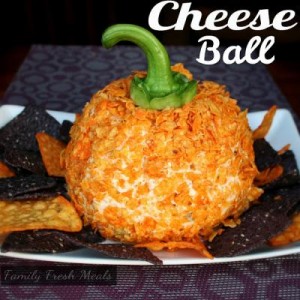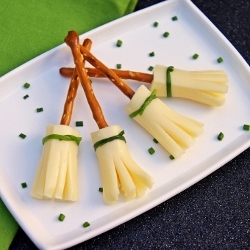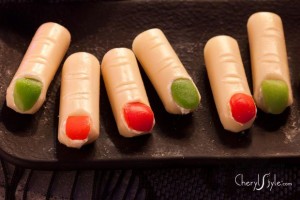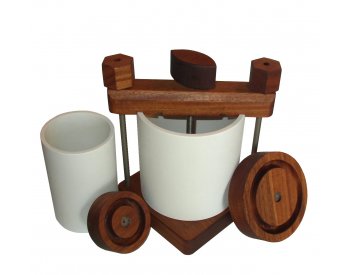Happy Halloween!
Before we get to the meat of this article…or should I say the cheese?…we thought we’d share a little Halloween trivia with you!
Halloween is thought to have originated around 4000 B.C., which means it has been around for over 6,000 years.
Fun Fact #2
Halloween was influenced by the ancient Roman festival Pomona, which celebrated the harvest goddess of the same name. Many Halloween customs and games that feature apples (such as bobbing for apples) and nuts date from this time.
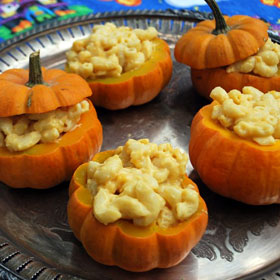 Fun Fact #3
Fun Fact #3
According to tradition, if a person wears his or her clothes inside out and walks backwards on Halloween, he or she will see a witch at midnight.
Fun Fact #4
Scottish girls believed they could see images of their future husband if they hung wet sheets in front of the fire on Halloween. Other girls believed they would see their boyfriend’s faces if they looked into mirrors while walking down stairs at midnight on Halloween.
Welcome to our Cheese Graveyard! Care to take a midnight stroll?
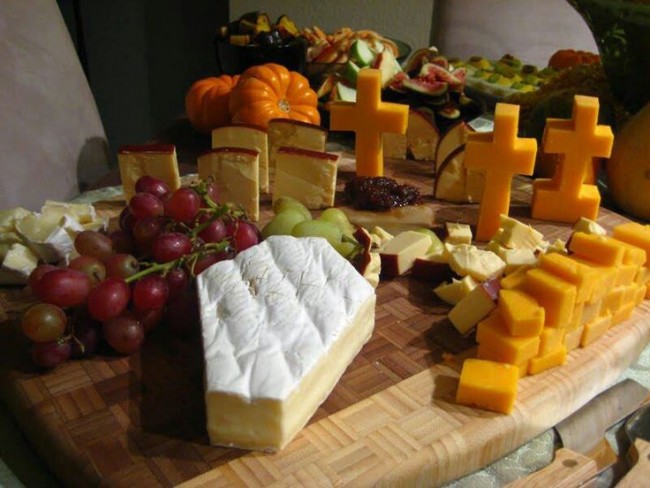
Wasn’t that fun?!
Okay, ready to get back to those pesky cheese holes? Here’s the article you’ve been waiting for. Read on!
Preventing Holes from Forming in Homemade Cheese
Sometimes we get calls from customers who have purchased our Ultimate Cheese Press asking what caused the unwanted tiny holes they found throughout their cheese. Folks ask if these holes are normal, what causes the them, and if the holey cheese is safe to eat.
Unwanted holes are a common problem in cheesemaking, so we decided to share the answers to these questions here in our blog. We’re also going to give you some tips on how you can prevent holes from forming in the cheese you make at home.
Okay, So Here’s the Deal
Small holes in a hard cheese are cosmetic problem, so a holey cheddar is perfectly safe to eat. You can minimize or prevent holes altogether by better regulating the temperature of the cheese curds at the start of the pressing process.
If a cheese has large holes in it and smells “off”—or just plain bad—throw it out!
Large holes and a foul odor mean the cheese is contaminated with bad bacteria and unsafe for human consumption.
How to Keep Holes from Forming in Your Cheese
Usually, you use a cheese press to make semi-hard to hard cheeses, like cheddar or romano. A press is used to put pressure on the curds; this releases excess whey and knits the cheese together. Harder cheeses require a warmer process for the cheesemaking technique, rather than the cooler process used for making soft cheeses, like cottage cheese or chevre.
If the cheese curds are allowed to cool too much as they are being placed in the cheese press, the curds will not knit together well and sometimes little holes will form in the cheese.
With more experience, you will be able to load the curds into the press more quickly—while they’re still very warm—and find ways to keep them warm at the critical time of pressing.
One way to keep the curds warm is to run your cheese mold under hot water. Quickly wipe the water off with a clean dish towel and place the mold onto the base of the press. Then load the mold with curds right away and set your press to pressing the curds. The heated plastic helps hold the heat so your curds don’t cool off too fast.
You can also wet the cheese cloth you’re using to line the molds in hot water, and squeeze out the excess. Quickly place the Ultimate Cheese Press on a cooling rack inside a cake pan to collect the released whey.
If the room temperature is cool, place a towel over the whole unit to try to keep the warmth within the press as long as possible.
This warm pressing process will result in a more flavorful cheese that has a smoother texture and is free of holes.
Remember, cheesemaking is a process of fermenting all the ingredients in to a wonderful cheese. You won’t hurt your cheese making it with a cooler process, but you will miss out on some of the bright flavors that can result from a warmer process.
Why Our Ultimate Cheese Press Makes Better Cheese
We designed our cheese press with plastic molds because plastic retains heat much better than stainless steel. No matter what you do, you can’t keep stainless steel from cooling off quickly. That’s why cheese presses with stainless steel molds are less reliable.
Our plastic molds give you much more control over the rate at which the curds cool down.
And the only way to get a truly great flavor in your hard cheeses is to keep the curds at a consistent warm temperature during this initial curing process.
If the curds are allowed to cool too quickly, small holes form in the flesh and the flavor of the cheese doesn’t develop as it should.
Plastic Cheese Molds are Safe and Non-Toxic
Some folks have asked about the safety of our plastic cheese molds. We use the same Food Grade PVC that’s used to bring fresh water to your home. This pipe is naturally free of Bisphenol-A (BPA).
A research scientist we spoke with told us that the harder the plastic, the less likely it is to leach out toxic chemicals. Our PVC pipe molds are 1/4″ thick and very hard.
You would have to heat our cheese molds to over 400 degrees Fahrenheit to get any release of chemicals. And the cheese making process doesn’t get those molds much warmer than 80 degrees.
Incidentally, the same scientist warned us that we should be more worried about all the cash register receipts we touch everyday because the thermal paper receipts contain loads of hormone-disrupting BPA that transfers onto our hands. Just think about how many times you touch your lips during the day. Or, how about the all the times you’ve grabbed a receipt in your mouth as you loaded the car?
After learning that our plastic molds are perfectly safe, especially when compared to the dangers of everyday cash register receipts, we decided to stick with plastic molds for our Ultimate Cheese Press!
Wishing you a safe and happy Halloween!
